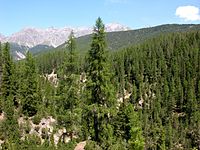
Photo from wikipedia
Floating vegetation island (FVI) provides an effective way to remove excessive nutrition and pollutants in rivers. The Reynolds stress model (RSM) is employed to investigate the hydrodynamic characteristics induced by… Click to show full abstract
Floating vegetation island (FVI) provides an effective way to remove excessive nutrition and pollutants in rivers. The Reynolds stress model (RSM) is employed to investigate the hydrodynamic characteristics induced by varied canopy densities of FVI in an open channel. In longitudinal direction, four regions are subdivided according to the flow development process: upstream adjustment region ( L UD ), diverging flow region ( L DF ), shear layer growth region ( L SD ), and fully developed region. The increasing canopy density accelerates the flow adjustment in the diverging flow region and shear layer growth region, signaling a shorter distance to reach an equilibrium stage, while L UD keeps a constant. The vertical profiles of the normalized velocity are found to be self-similar downstream of the diverging flow region. In the vertical direction, the streamwise velocity profiles in the mixing layer collapse for all densities and obey the hyperbolic tangent law. Normalized penetration depth into the canopy was fitted as a function of dimensionless canopy density given by δ c / h c = 0.404( C D ah c ) −0.316 . This finding indicates a large space for rapid water renewal between the canopy region and the underlying water driven by the shear-scale vortices. In the lateral direction, the intensification of secondary current and the increasing number of secondary current cells with increasing canopy density reveal that dense floating canopies contribute to strong momentum exchange. The centers of vortices move as canopy density increases, while the vortices in canopy region do not merge with those in the gap region, as limited by the height and width of the canopy region. The distribution of longitudinal velocity in the transects is significantly influenced by secondary current.
Journal Title: Journal of Hydrodynamics
Year Published: 2020
Link to full text (if available)
Share on Social Media: Sign Up to like & get
recommendations!